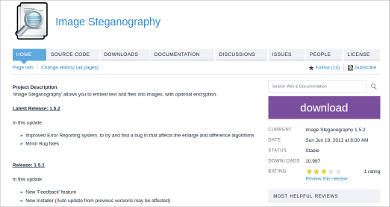
Suppose we have three bytes representing one particular color, in this case orange: Pixels in a color image can be represented by 3 bytes, one each for RGB (Red, Green, Blue).
Best steganography app for mac software#
Also, they are pretty easy for security software to detect because of their unexpected format.Ī better approach is to get down into the code at a binary level and manipulate the least significant bits (LSB) of individual pixels. First, they inflate the file size and secondly, they change the file’s hash. These kinds of simple techniques may be useful for exfiltrating user data, perhaps, but they suffer drawbacks. jpg file contains a secret 28 byte text file, msg.txt. In this example, the file new.jpg displays a picture when opened in an image viewer application, but when inspected using the WinRaR archiving utility, we can see that the unpacked. A malicious actor or program, though, can easily extract the appended file. An image viewer only reads the code that relates to displaying the image and ignores any other files contained within the archive.
Best steganography app for mac archive#
The same idea can be used to attach a complete file to an image using the RAR archive format. In this case, we’ll just use the xxd utility to reverse the hexadecimal and print it out in plain text.Įcho 68 65 6c 6c 6f 20 77 6f 72 6c 64 0a | xxd -r -p The plain text string can easily be dumped out or read by a program. The output from hexdump shows us the extra bytes added. Here, we simply append “hello world” to the end of the file. Doing so does not prevent the image from being displayed normally, nor does it change the image’s visual appearance. One simple method is simply to append a string to the end of the file. To understand how image steganography works, let’s take a look at some basic ways you can hide text in an image file. Depending on the technique used, this can also be done without inflating the overall file size of the original image.

In fact, given the nature of image file formats, it’s possible to conceal not just text strings but to also hide entire files in. In this trivial example, it is the human brain that decodes the concealed message in the plain text, but computer programs read bytes, not natural language, and this turns out to make it possible to conceal messages in plain sight that are easy for computers to parse and simultaneously almost impossible for humans to detect without assistance. Although the implementation of image steganography is far more technical, it’s basically the same idea at a lower level. The secret message, “HelLo, worlD’ is not encoded, the viewer only has to know to look at the message in a certain way to reveal it, and we didn’t have to add any extra data to the “carrier” in order to transmit it. A simple example using a familiar technique illustrates the basic idea behind steganography: Steganographic messages, on the other hand, look like ordinary messages but artfully conceal something unexpected. Cryptographic messages are obviously hiding something: they typically look like gibberish and require specialist methods to decode. Steganography is a form of obfuscation that is quite different from cryptography, which is the practice of writing coded or encrypted messages. When they open a picture on a device, few people ever have reason to look beyond the visual presentation displayed to what lies hidden inside the. While it’s not necessary that either the hidden data or the carrier file have to be images, the fact that digital images are just streams of bytes like any other file makes them a particularly effective medium for concealing secret text and other data. Often just referred to as stego, the practice of concealing messages or information within other non-secret text - inside a “carrier” message - means malicious actors can use this technique to compromise devices just by hosting an image on a website or sending an image via email. Steganography is a technique that can hide code in plain sight, such as within an image file. In this post, we take a look at what steganography is and how it is being used by threat actors.

Over the past few years, there has been a noticable increase of in-the-wild malware campaigns using the art of steganography and steganographic-like tricks to embed hidden messages in pictures and other “carrier” files.


The kind of metadata associated with Facebook and Instagram pictures, though, is nothing compared to the sophisticated methods threat actors use to craft images that can deliver malicious code or exfiltrate user data. As many Facebook users already discovered when a partial outage revealed the hidden image tags attached to users’ pictures, images can carry a lot of data that’s normally invisible to the human eye.


 0 kommentar(er)
0 kommentar(er)
